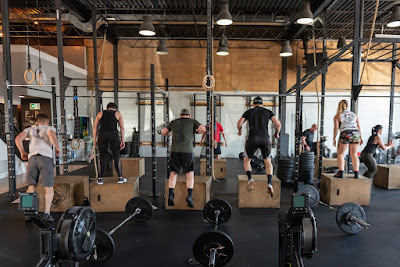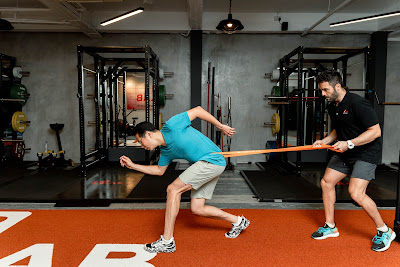Group Fitness Showdown: Comparing The Benefits of Different Classes
In the bustling world of fitness, group classes have emerged as popular and effective ways to stay active. From high-intensity workouts to mind-body practices, the options seem endless. In this group fitness showdown, we'll compare the benefits of different classes, helping you find the perfect fit for your fitness goals and preferences.
1. Bold Heading: The Cardio Crush - Spin vs. Dance Aerobics
Bold Heading: Pedals vs. Grooves
In the cardio realm, spin classes and dance aerobics take center stage. Spin classes, conducted on stationary bikes, offer a high-intensity cardiovascular workout that targets the lower body. On the other side, dance aerobics inject fun into the equation, combining dance routines with aerobic exercises to enhance cardiovascular fitness. Both classes boost endurance, but spin leans towards lower body strength, while dance aerobics provides a full-body dance-party workout.
2. Strength Showdown - CrossFit vs. Body Pump
Bold Heading: Barbells and Burpees vs. Pumped-Up Reps
For those seeking strength gains, CrossFit and Body Pump stand out. CrossFit is known for its varied, intense workouts that blend weightlifting, cardio, and functional movements. It promotes overall strength and conditioning. Body Pump, on the other hand, focuses on high-repetition, low-weight resistance training. It's a sculpting powerhouse that hones in on muscle endurance and definition.
3. Mind-Body Meltdown - Yoga vs. Pilates
Bold Heading: Zen Mat vs. Core Control
In the realm of mind-body connection, yoga and Pilates take the lead. Yoga, with its diverse styles, emphasizes flexibility, balance, and mindfulness. It promotes relaxation while building strength. Pilates, centered around core strength and controlled movements, aims to enhance overall stability and posture. Both practices foster mind-body harmony but with distinct approaches.
4. Martial Arts Mayhem - Kickboxing vs. Brazilian Jiu-Jitsu
Bold Heading: Strikes and Kicks vs. Ground Control
Martial arts-inspired classes offer dynamic and engaging workouts. Kickboxing, with its combination of punches and kicks, is a high-intensity cardiovascular workout that also improves agility. Brazilian Jiu-Jitsu (BJJ) focuses on ground fighting and submissions, providing an effective full-body workout that enhances flexibility and core strength. Choose between striking moves in kickboxing or the ground-control focus of BJJ based on your preferences.
5. Flexibility Face-Off - Barre vs. Stretching Classes
Bold Heading: Micro Movements vs. Lengthening Limbs
For those aiming to improve flexibility and tone muscles, Barre and traditional stretching classes are top contenders. Barre classes incorporate small, isometric movements to target specific muscle groups, promoting long, lean muscles. Traditional stretching classes focus on elongating muscles through dynamic and static stretches, improving overall flexibility. Both options contribute to improved range of motion and reduced muscle tightness.
6. Aquatic Adventures - Aqua Zumba vs. Water Aerobics
Bold Heading: Splashy Dance vs. Resistance Ripples
Water-based classes add a refreshing twist to group fitness. Aqua Zumba turns the pool into a dance floor, combining dance moves with the resistance of water. It's a high-energy workout with a low impact on joints. Water aerobics, on the other hand, offers a versatile full-body workout with resistance from the water. Choose between the splashy rhythm of Aqua Zumba or the resistance ripples of water aerobics for a unique aquatic fitness experience.
7. Coordination Challenge - Step Aerobics vs. Functional Fitness
Bold Heading: Step Sequences vs. Everyday Movements
Coordination is the name of the game in step aerobics and functional fitness classes. Step aerobics incorporates choreographed sequences using a step platform, enhancing cardiovascular fitness and coordination. Functional fitness, meanwhile, focuses on movements that mimic everyday activities, promoting strength, balance, and coordination in real-life scenarios. Choose between the structured step sequences or the practical, functional movements for a coordination challenge.
8. HIIT Havoc - Tabata vs. AMRAP
Bold Heading: Intervals of Intensity vs. Reps without Rest
High-Intensity Interval Training (HIIT) has taken the fitness world by storm, and two popular formats are Tabata and AMRAP (As Many Rounds As Possible). Tabata involves 20 seconds of intense exercise followed by 10 seconds of rest, repeated for four minutes. It's a quick, efficient way to torch calories. On the other hand, AMRAP challenges you to complete as many rounds of a set of exercises as possible within a specific time frame. Both deliver a potent calorie burn and cardiovascular boost.
9. Group Cycling Grind - Indoor Cycling vs. Outdoor Group Rides
Bold Heading: Stationary Sprint vs. Outdoor Adventure
Group cycling offers diverse options, including indoor cycling classes and outdoor group rides. Indoor cycling involves pedaling on stationary bikes to the rhythm of music, providing a controlled environment for intense cardio. Outdoor group rides add an element of adventure, combining the benefits of cycling with fresh air and varied terrain. Choose between the rhythmic intensity of indoor cycling or the outdoor escapade of group rides based on your preference and weather conditions.
10. Dance Dynamics - Hip Hop vs. Zumba
Bold Heading: Urban Beats vs. Latin Rhythms
If you enjoy dance-infused workouts, Hip Hop and Zumba are likely on your radar. Hip Hop classes fuse urban dance moves with cardio, making it a dynamic and rhythmic experience. Zumba, inspired by Latin dance, offers a lively and inclusive atmosphere. Both classes are excellent for burning calories, enhancing coordination, and, most importantly, having a blast on the dance floor.
11. Fusion Fitness - Bootcamp vs. Circuit Training
Bold Heading: Military-Style vs. Circuit Variety
Bootcamp and circuit training classes provide a fusion of exercises for a comprehensive full-body workout. Bootcamp often incorporates military-style drills, combining strength and cardio. Circuit training, on the other hand, involves rotating through different exercises with minimal rest. The diversity in both classes ensures that no muscle is left untouched, making them ideal for those seeking a well-rounded fitness challenge.
12. Strength in Balance - Barbell Classes vs. Kettlebell Workouts
Bold Heading: Power Lifting vs. Functional Swings
Strength-focused classes often involve the use of weights, and barbell classes and kettlebell workouts present distinct approaches. Barbell classes typically emphasize powerlifting moves like squats, deadlifts, and bench presses. Kettlebell workouts, on the other hand, focus on dynamic, functional movements that engage multiple muscle groups simultaneously. Choose based on your preference for heavy lifting or dynamic, full-body exercises.
13. Mindful Movement - Tai Chi vs. Body Balance
Bold Heading: Ancient Harmony vs. Modern Fusion
For a mindful approach to movement, Tai Chi and Body Balance offer unique experiences. Tai Chi, an ancient Chinese martial art, emphasizes slow, flowing movements to enhance balance and harmony. Body Balance combines elements of yoga, Pilates, and Tai Chi to create a modern fusion class that promotes flexibility, strength, and mental well-being. Explore the serenity of Tai Chi or the multifaceted balance of Body Balance for a mindful movement experience.
14. Community Connection - CrossFit vs. Spartan Training
Bold Heading: Team Spirit vs. Obstacle Challenge
If you're drawn to a sense of community and camaraderie, CrossFit and Spartan Training might be your calling. CrossFit classes often involve group workouts, fostering a supportive community atmosphere. Spartan Training, inspired by obstacle course races, combines strength and endurance drills with obstacle challenges. Both classes offer a sense of teamwork and accomplishment, making fitness a social adventure.
15. Athletic Ascent - Vertical Climbing vs. Parkour
Bold Heading: Climbing Heights vs. Urban Movement
For those seeking unconventional challenges, vertical climbing and parkour classes present unique options. Vertical climbing classes, often using specialized equipment, simulate climbing mountains or skyscrapers for an intense cardiovascular workout. Parkour focuses on fluid, efficient movement through urban environments, enhancing agility and spatial awareness. Decide whether you prefer the heights of climbing or the urban movement of parkour to add an adventurous twist to your fitness routine.
Conclusion: Tailoring Your Fitness Tapestry
In conclusion, the world of group fitness is a vibrant tapestry, with each class offering a unique thread of benefits. The key to a fulfilling fitness journey is finding the classes that align with your goals, preferences, and sense of adventure. Whether you thrive in the intensity of HIIT or find serenity in mindful movement, there's a group fitness class waiting to become a vibrant part of your tailored fitness tapestry.
FAQs
Can I switch between different group fitness classes to keep my routine interesting?
Absolutely. Switching between different group fitness classes is an excellent way to keep your routine dynamic and prevent boredom. It also challenges your body in diverse ways, promoting overall fitness. Consider creating a weekly schedule that includes a mix of classes to keep things interesting.
Are there group fitness classes suitable for seniors or individuals with limited mobility?
Yes, many fitness facilities offer classes specifically designed for seniors or individuals with limited mobility. These classes often focus on gentle movements, flexibility, and balance exercises to cater to the specific needs of participants. Check with local fitness centers or community programs for suitable options.
What's the importance of rest days in a group fitness routine?
Rest days are crucial in a group fitness routine to allow your body time to recover and prevent overtraining. Group classes can be intense, and adequate rest promotes muscle repair, reduces the risk of injury, and ensures sustained energy levels. Listen to your body and schedule rest days as needed.
Can I combine group fitness classes with individual workouts at the gym?
Absolutely. Combining group fitness classes with individual workouts at the gym provides a balanced approach to fitness. Group classes offer variety, social interaction, and structured workouts, while individual gym sessions allow you to focus on specific goals or target areas. The combination provides a well-rounded fitness routine.
What should I consider when choosing between high-impact and low-impact group fitness classes?
The choice between high-impact and low-impact classes depends on your fitness level, any existing injuries or joint concerns, and personal preferences. High-impact classes, like running or HIIT, offer intensity but may be challenging for joints. Low-impact options, such as swimming or cycling, provide gentler alternatives with reduced impact on joints. Consider your own comfort and physical condition when making this choice.



.jpg)
